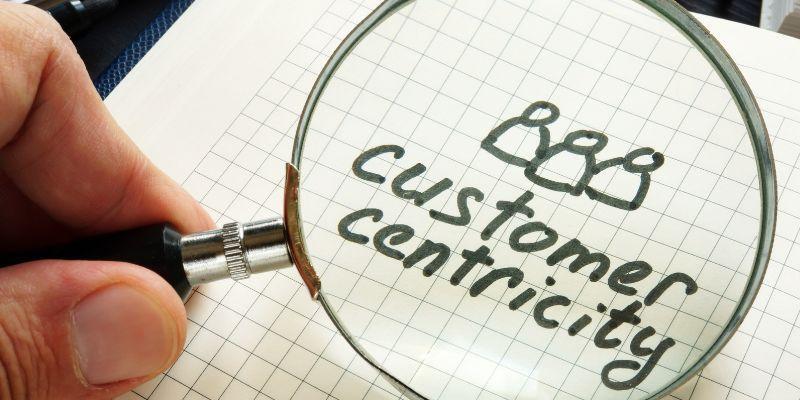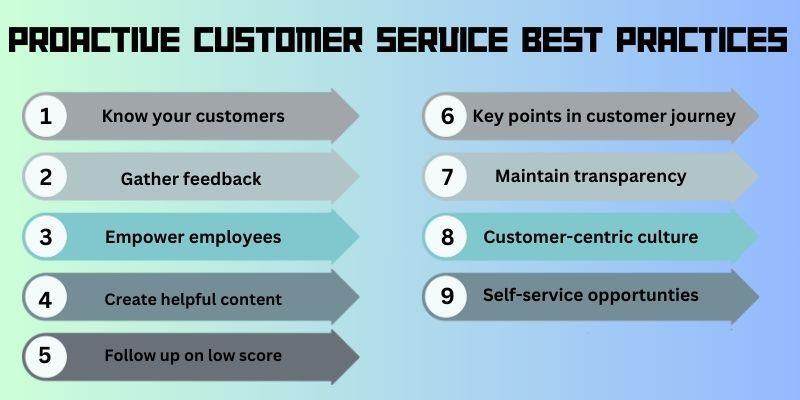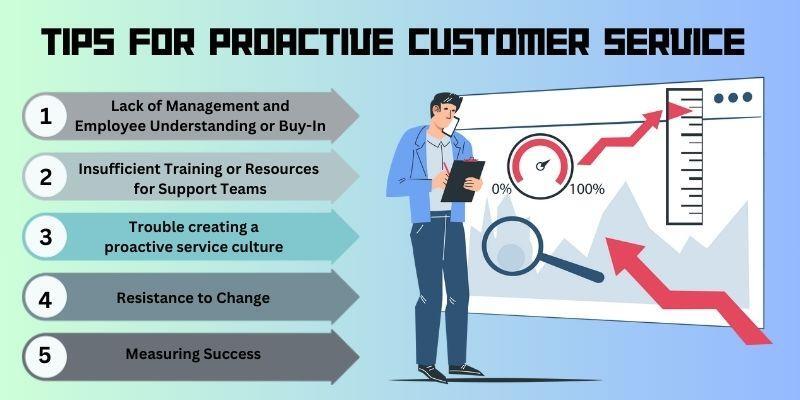In today’s fast-paced world, businesses must do more than just respond to customer inquiries. They need to anticipate problems and offer solutions before customers even realize an issue. This is where proactive customer service becomes essential.
When taking action ahead of time, companies can differentiate themselves from competitors and build lasting relationships with their customers.
Consider how Amazon—one of the world’s leading e-commerce giants—proactively informs customers if there’s a delay in shipping well before the expected delivery date. This not only reduces customer frustration but also strengthens trust in the brand.
In contrast, reactive customer service involves waiting for the customer to contact us to inquire about the delay, often leading to negative experiences.
When adopting proactive customer care strategies, businesses can create smoother, more positive experiences, ultimately leading to greater customer satisfaction and loyalty.
Let’s explore this in more detail ahead.
What is Proactive Customer Service?
Proactive customer service involves anticipating customer needs and addressing potential issues before they arise. Instead of waiting for customers to contact them with a complaint, businesses take the initiative to solve problems or offer assistance first.
This approach is the opposite of reactive customer service, where businesses only act once a problem is reported.
For instance, Netflix takes a proactive approach by notifying users via email when their payment method is about to expire. This helps customers avoid service disruptions and ensures a smooth streaming experience.
Similarly, Airbnb proactively communicates with guests about any changes or updates to their reservations, ensuring they have a smooth travel experience without needing to inquire.
In a retail setting, think of a waiter at a restaurant in Paris refilling a customer’s water glass before it’s empty.
This simple action is an example of proactive help, ensuring the customer’s needs are met before they even ask. Conversely, waiting for the customer to request a refill would be a reactive approach.
Proactive customer service creates a uniform, stress-free experience that keeps customers satisfied and loyal.
The Shift Towards Customer-Centricity

As customers become more encouraged and knowledgeable, their expectations of businesses have shifted. Today’s consumers expect companies to be customer-centric, prioritizing customer needs and making it easy for them to have positive experiences.
Proactive customer service plays a crucial role in meeting these expectations, helping businesses to be seen as caring and attentive.
A great example of this shift is Tesla, the global leader in electric vehicles. Tesla often uses over-the-air software updates to fix potential issues with its cars before customers even know about them.
When automatically updating vehicles and improving performance without requiring customers to visit a service center, Tesla demonstrates proactive support services that enhance the overall customer experience.
This level of proactive customer communication ensures that users feel cared for without reaching out for help, aligning with the shift toward customer-centricity.
Brands that need to adopt these strategies avoid falling behind in a market where customers expect businesses to go above and beyond in catering to their needs.
Benefits of Proactive Customer Service
There are many benefits to adopting a proactive customer service approach. Businesses can improve customer satisfaction, loyalty, and profitability by addressing potential issues early on. Here are some key benefits:
- To prevent problems from escalating into significant issues, British Airways sends notifications about flight changes or cancellations well in advance, allowing customers to make alternate travel plans before they are severely impacted.
- Saving customers time and effort: Apple provides proactive support by notifying them when their devices need software updates or battery replacements. This prevents future malfunctions and saves customers the hassle of troubleshooting.
- Building customer loyalty and retention: Nordstrom, a leading fashion retailer, proactively contacts customers who have had negative experiences to offer personalized solutions. This approach turns potential dissatisfaction into loyalty by showing that the company cares about customer happiness.
- Gathering valuable customer feedback: Many companies like Zappos ask for feedback immediately after a purchase or customer interaction, allowing them to address potential issues before they escalate.
- Reducing the need for support calls: Google proactively provides extensive online resources and troubleshooting guides, helping users solve problems independently and reducing the volume of customer service inquiries.
- Getting ahead of customer conversations: Slack, the workplace communication tool, frequently updates users on new features and how to use them effectively. This proactive communication helps customers make the most of the platform without asking for help.
- Creating brand advocates and ambassadors: Lululemon, known for its customer-centric service, often surprises loyal customers with personalized outreach, such as invitations to exclusive events or product releases. This kind of proactive engagement turns satisfied customers into enthusiastic brand ambassadors.
Best Practices for Implementing Proactive Customer Service

For businesses looking to implement proactive customer support, here are some actionable steps:
- Get to know your customers and their needs: Use data analytics and customer insights to anticipate potential issues. For example, Netflix uses viewing habits to recommend new content, keeping users engaged without needing to search for it.
- Gather feedback through various channels: Amazon regularly asks for product reviews and uses this data to improve services; businesses should actively seek feedback to stay ahead of customer expectations.
- Empower employees with knowledge and resources: Zappos gives its customer service agents the freedom to provide personalized solutions, ensuring they can offer proactive support without needing approval from higher-ups.
- Create helpful content and self-service resources: Dropbox offers comprehensive FAQs and support articles to help customers resolve issues independently, reducing the need for reactive service.
- Follow up promptly on low customer satisfaction scores: For instance, Southwest Airlines follows up with passengers who rate their experience poorly, offering solutions to improve future interactions.
- Identify key moments in the customer journey to engage proactively: IKEA contacts customers after their purchases to ensure their furniture assembly went smoothly, reducing future issues and complaints.
- Maintain transparency and honesty when issues arise: Microsoft frequently updates service outages and technical issues, informing customers of the steps to resolve the problem.
- Build a customer-centric culture within the organization: Encourage every employee to think about providing proactive customer service, like Ritz-Carlton, which empowers all staff to go above and beyond to delight guests.
- Provide self-service opportunities through knowledge bases and chatbots: HubSpot, a leading CRM platform, uses AI-powered chatbots to offer solutions before customers proactively contact human agents.
Challenges to Implementing Proactive Customer Service

While proactive customer service can provide many benefits, implementing it within an organization comes with challenges.
From gaining management buy-in to changing ingrained habits, businesses must overcome several obstacles to adopt a proactive approach successfully. Below are some key challenges companies face and potential solutions to overcome them.
1. Lack of Understanding or Buy-In from Management and Employees
One major challenge businesses face is the need for more awareness or support for proactive customer care from both management and employees. If leadership needs to fully understand the value of proactive service, they may be hesitant to invest the necessary time and resources.
Similarly, employees might need to see how their day-to-day actions contribute to proactive service, which might make it difficult for them to adopt the change.
Solutions:
- Conduct workshops or training sessions focusing on proactive customer service benefits. For example, companies like Disney regularly host staff training on delivering exceptional customer service, which includes proactive addressing of guest needs.
- Develop a clear communication strategy that outlines the vision for proactive service and shows how it aligns with the company’s overall goals and success. For example, Ritz-Carlton hotels emphasize the importance of customer service in all employee interactions, ensuring proactive service is a key part of their culture.
2. Insufficient Training or Resources for Support Teams
With adequate training or resources, support teams can anticipate customer needs effectively.
Many businesses, such as customer relationship management (CRM) systems or data analytics platforms, need more tools and technology to provide proactive support. This can lead to missed opportunities to engage customers and prevent problems from escalating.
Solutions:
- Invest in comprehensive training programs that equip support teams with the skills needed to anticipate and address customer needs before they arise. For instance, Zappos empowers its customer service agents to take initiative and offer creative solutions to problems without management approval.
- Implement technology solutions like CRM systems and analytics tools to help track customer interactions and predict future needs. Salesforce, a leading CRM platform, provides businesses with real-time insights into customer behavior, allowing them to proactively offer help.
3. Difficulty in Creating a Culture that Prioritizes Proactive Service
Another challenge is changing a company culture that may be ingrained in reactive habits. Employees who are used to only addressing issues after they occur might need a more proactive approach.
Additionally, companies focused on cost-cutting or efficiency may overlook the long-term benefits of investing in proactive service strategies.
Solutions:
- Leadership should promote a customer-centric culture by recognizing and rewarding employees who exemplify proactive behaviors. Southwest Airlines is known for its customer-first approach; employees are encouraged to go the extra mile for passengers.
- Integrate proactive service principles into performance metrics and evaluations, ensuring all team members understand how their actions contribute to the company’s success.
4. Resistance to Change
Resistance to change is common in many organizations, especially when it involves altering long-standing processes.
Employees may perceive proactive customer service as additional work or unnecessary, particularly if they are used to a reactive approach. This resistance can slow down or derail efforts to implement proactive customer support strategies.
Solutions:
- Encourage open dialogue, allowing employees to voice concerns and provide feedback during the transition to proactive service. Google is known for advancing a culture of innovation and open communication, which helps reduce resistance to new initiatives.
- Involve employees in developing new processes, which promotes a sense of ownership and reduces resistance. When employees feel they have a role in shaping the company’s future, they are more likely to welcome change.
5. Measuring Success
Measuring the impact of proactive customer service can be challenging, especially if clear metrics or benchmarks are lacking. Without effective ways to measure success, it can be difficult to assess whether proactive service efforts are working or need adjustment.
Solutions:
- Establish specific KPIs (Key Performance Indicators) that align with proactive customer service goals. For example, Zendesk, a customer service software provider, tracks metrics like response times, customer satisfaction scores, and retention rates to measure the success of their proactive service strategies.
- Review these metrics regularly to ensure continuous improvement. Amazon is known for its data-driven approach, using customer feedback and performance metrics to continuously refine its service strategies and deliver a proactive customer experience.
FAQs
How to be more proactive with customers?
To be more proactive with customers, businesses can use data and analytics to anticipate needs, offer timely support, and provide updates before issues arise. For example, Netflix proactively notifies users when payment details need updating, preventing service interruptions.
What is an example of a proactive approach?
American Express takes a proactive approach by contacting customers about suspicious transactions before they notice, preventing fraud, and ensuring customer peace of mind.
How can proactive customer service improve customer retention?
Proactive customer care can significantly improve customer retention by addressing problems before they escalate and providing helpful solutions. For instance, Nordstrom proactively follows up with customers after negative experiences to resolve issues and promote loyalty.
How does proactive customer service impact brand loyalty?
Proactive communication shows customers that a brand values their experience, leading to greater trust and loyalty. Brands like Apple proactively notify customers about product updates, keeping them engaged and satisfied.
How can proactive customer service reduce customer complaints?
Proactive support services reduce complaints by solving issues before they become problems. For example, Tesla uses over-the-air software updates to fix car performance issues before customers notice, leading to fewer complaints.
Conclusion
Proactive customer service is a powerful strategy that helps businesses stand out in a competitive market. By anticipating customer needs and addressing potential issues before they arise, companies can build stronger relationships, increase loyalty, and reduce the risk of customer churn.
From Apple’s proactive notifications to Tesla’s over-the-air updates, real-world examples show how this approach leads to greater customer satisfaction and long-term success.
To stay ahead, businesses must adopt proactive customer care by using data-driven insights, training staff, and adopting the right technology.
As customers’ expectations evolve, companies that prioritize a proactive approach will gain a competitive edge, delivering exceptional experiences that keep customers returning.
BOOK A FREE DEMO





